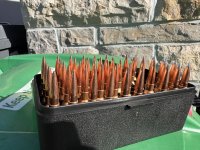I may be overthinking this.
So if I use one bullet let’s say the 140 ElDM to find the lands and get a CBTO measurement there.
Now if I want to seat 0.020 off that point I just adjust down my seating die etc. pretty simple.
Now if I have second bullet let’s say the 153 ATIP can I use the above CBTO of lands and adjust accordingly.
My understanding is that the OGIVE is the point the bullet engages the rifling. So that theoretically should be same across all brands of bullets? Obviously at a different point on each type of bullet but CBTO to lands should be same across all bullets?
Thanks
Mike
So if I use one bullet let’s say the 140 ElDM to find the lands and get a CBTO measurement there.
Now if I want to seat 0.020 off that point I just adjust down my seating die etc. pretty simple.
Now if I have second bullet let’s say the 153 ATIP can I use the above CBTO of lands and adjust accordingly.
My understanding is that the OGIVE is the point the bullet engages the rifling. So that theoretically should be same across all brands of bullets? Obviously at a different point on each type of bullet but CBTO to lands should be same across all bullets?
Thanks
Mike


